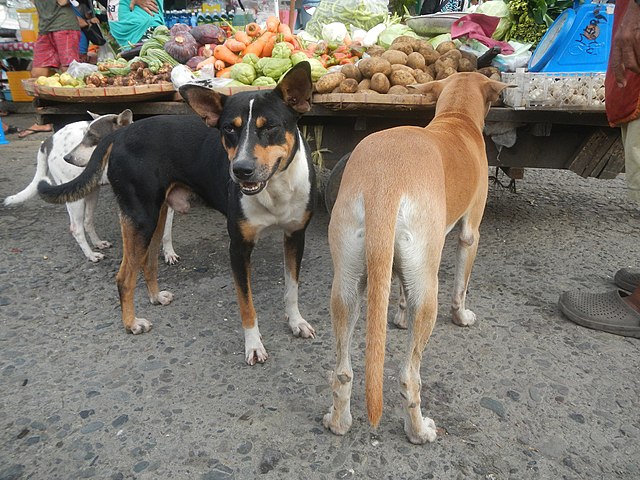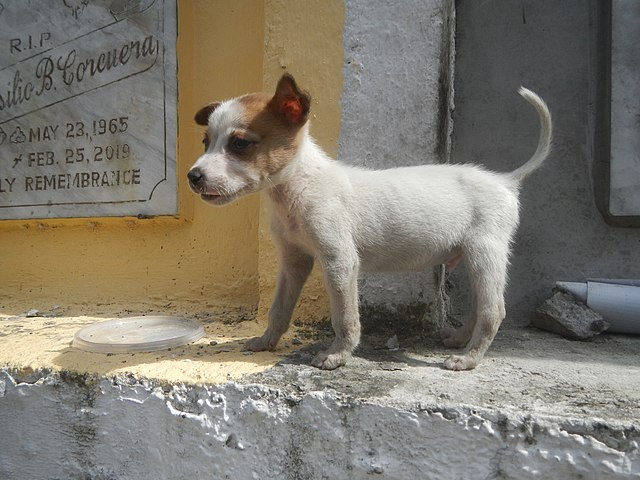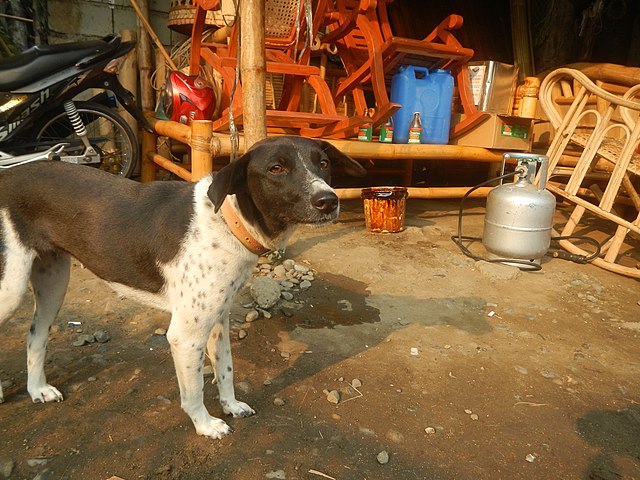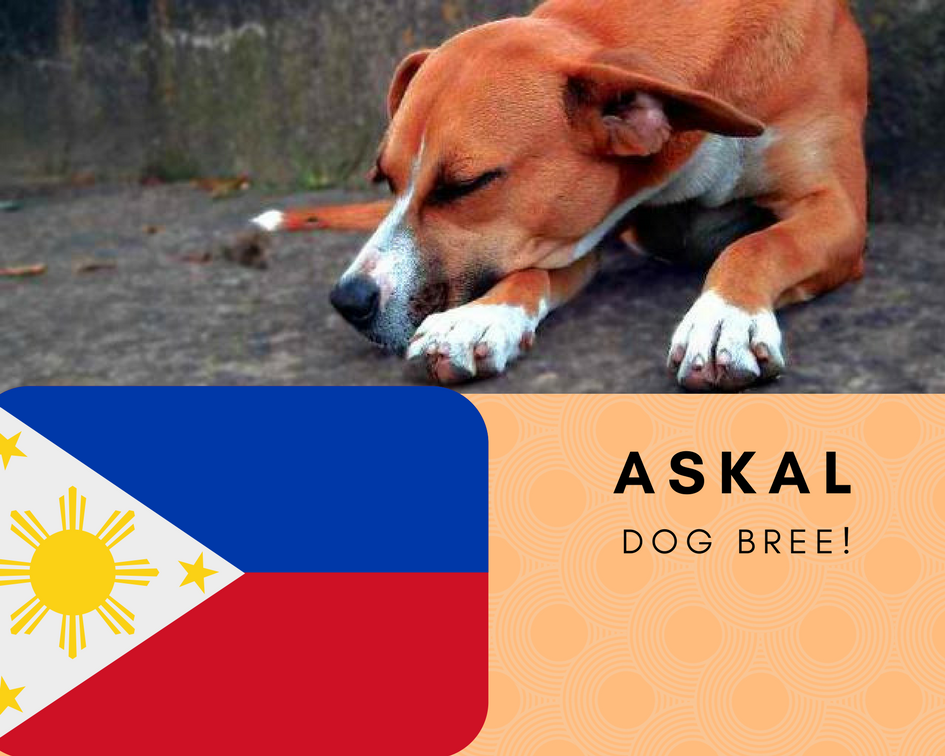| Other Names | Askals or Aspins or Mongrel dogs |
| Height | Female 12-16 inches Males 14-19 inches |
| Coat colours | Black, Brown, Brindle, Gray, Cream and White. |
Askal is the Filipino language name for the indigenous and/or mongrel dogs, often street dogs (asong kalye) in the Philippines.
The coat can be short-haired or rough. Coat colours range from Black, Brown, White, Red, Brindle, Gray, and Cream. In askal Spots are commonly found at the base of the tail and the back in a semi-circular fashion. The snout sometimes appears black if the coat colour is brown. The askal’s tail is usually held high and the ears can be floppy, semi-floppy or fully pointing upwards. The bone structure of a native Askal is on the medium range, never heavy like in Rottweilers.
Askals dog has been raised traditionally as guard dogs in the Philippines. They are naturally suspicious of strangers, independent and protective of family members. They are good for young children as companions, due to their devotion to family members. They are trusted by their owners to roam markets or the neighbourhood to socialize with other dogs which is why these dogs are seen by the Western people as stray dogs when, in fact, they are not. Askal dog is, however, expected to be home before dusk, especially males who always look for females in heat. Female dogs usually stay at home and are excellent watchdogs. askals were allowed to compete in the First Philippine Dog Agility Championships in 2013. At the 2015 Pet Express Doggie Run in Pasay City, askals were the featured dog. The dogs featured in an essay by Gilda Cordero-Fernando. Askals have been trained by the Coast Guard to identify bombs and drugs by scent.
History and Origins:

The Askal dog breed is indigenous to the Philippines and is also known as the “Aspin,” which stands for “Asong Pinoy” or “Philippine Dog.” They are considered a mongrel breed, meaning they are not purebred and are often a mix of various breeds.
The exact history of the Askal breed is unknown, but it is believed that they have been living on the streets of the Philippines for centuries. These dogs were often used as guard dogs by Filipino families, protecting their homes from intruders and other animals.
As Askal dogs were bred for their functionality rather than their appearance, they have a wide range of physical characteristics, including size, coat color, and length. They can have short or rough coats, and their coat colors can range from black, brown, white, red, brindle, gray, and cream. They can also have spots, usually found at the base of their tail and back in a semi-circular fashion.
Despite being considered a street dog by many, the Askal breed is highly valued by many Filipinos for their loyalty, intelligence, and protective instincts. They are naturally suspicious of strangers and are known to be independent and protective of their family members.
In recent years, the Askal breed has gained popularity outside of the Philippines due to their unique qualities and temperament. They are becoming more recognized as a breed and are being trained for various tasks, including bomb and drug detection, search and rescue, and agility competitions.
Overall, the Askal dog breed is a fascinating breed with a rich history and unique characteristics that set them apart from other breeds. By sharing this information on your web page, you can help educate others on the origin and history of this amazing breed and attract more organic traffic to your website.
Care and Training
Feeding and Nutrition: As with any dog breed, proper nutrition is essential for the health and well-being of your Askal dog. Provide your dog with high-quality dog food and ensure that they are receiving the necessary vitamins and minerals.
Grooming: Askal dogs have a wide range of coat types and lengths, so grooming needs may vary depending on the individual dog. However, it is important to brush your dog regularly to prevent matting and remove loose hair. Regular baths are also necessary to keep your dog clean and healthy.
Exercise: Askal dogs are highly active and require regular exercise to maintain their physical and mental health. Daily walks or runs, interactive playtime, and training sessions can help keep your Askal dog healthy and happy.
Training: Askal dogs are intelligent and trainable, but may have some independent streaks due to their history as street dogs. Positive reinforcement training methods are highly recommended to build a strong bond with your dog and ensure effective training.
Socialization: Askal dogs are naturally protective of their family members, but proper socialization with other people and dogs is essential for their mental well-being. Introduce your Askal to new situations and people early on to help them develop into well-adjusted and well-behaved dogs.
Health Issues: Like all dogs, Askal dogs may be prone to certain health issues such as hip dysplasia and skin allergies. Regular veterinary check-ups and preventative care can help keep your Askal healthy and prevent any potential health issues from becoming more serious.
Personality Traits:

Intelligence: Askal dogs are known for their high level of intelligence, which makes them easy to train and capable of learning a wide range of commands and tricks.
Loyalty: Askal dogs are loyal to their family members and can form strong bonds with their owners. They are often protective of their family and home.
Playful: Askal dogs are energetic and playful, making them a great companion for active individuals and families with children.
Alertness: Askal dogs have a natural instinct to be alert and suspicious of strangers, which makes them great watchdogs. They are quick to sound the alarm if they sense any potential danger.
Adaptability: Askal dogs are adaptable and can adjust to different environments and lifestyles. They are often seen as street dogs in the Philippines but can also make great indoor pets.
Independence: Askal dogs have a bit of an independent streak due to their history as street dogs. They may require some patience and persistence during training, but they are capable of forming strong bonds with their owners.
Comparison to Other Breeds:

Temperament: One of the main factors that sets Askal dogs apart from other breeds is their temperament. While some breeds are known for being highly energetic or aggressive, Askal dogs are generally laid-back, friendly, and loyal. Highlight these qualities in comparison to other breeds that may have different temperaments.
Trainability: Another factor to consider when comparing Askal dogs to other breeds is their trainability. While some breeds are highly trainable and excel at tasks like obedience training or agility competitions, Askal dogs may require more patience and persistence when it comes to training. Highlight the unique challenges and rewards of training an Askal dog in comparison to other breeds.
Health and Lifespan: When comparing Askal dogs to other breeds, it’s important to consider their health and lifespan. While Askal dogs are generally healthy and long-lived, some breeds may be more prone to certain health conditions or have shorter lifespans. Discuss these differences and how they can impact the care and maintenance of the dog.
Grooming and Maintenance: Finally, when comparing Askal dogs to other breeds, it’s important to consider their grooming and maintenance needs. While some breeds require extensive grooming and maintenance, Askal dogs are generally low-maintenance and easy to care for. Highlight these differences in comparison to other breeds that may require more time and attention to keep them looking and feeling their best.
By comparing Askal dogs to other breeds, you can help potential pet owners understand the unique qualities and challenges of this breed, while also highlighting the many benefits of bringing an Askal dog into your home.
